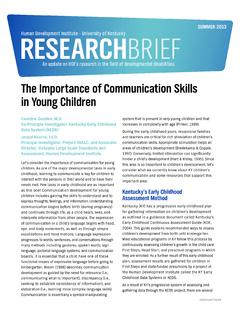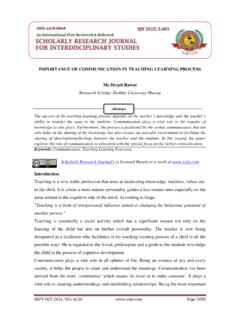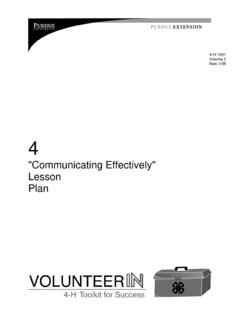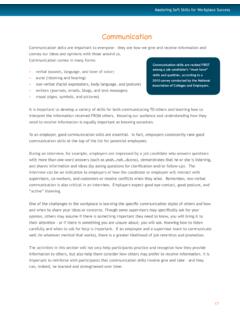Transcription of The Importance of Communication in the Classroom: The ...
1 Ii The Importance of Communication in the Classroom: The Impact of Effective Communication Skills on Student Enthusiasm by Angela Diloyan Presented to the Department of English & Communications in Partial Fulfillment of the Requirements for the Degree of Bachelor of Arts Yerevan, Armenia May 5, 2017 ii Table of Contents Abstract .. ii Section 1: Introduction .. 1 Section 2: Literature Review .. 2 Section 3: Research Questions .. 9 Section 4: Methodology .. 10 Section 5: Research Findings and Analysis ..13 Section 6: Conclusion and Recommendations ..22 Section 7: Limitations and Avenues for Future Research ..23 Works Cited ..24 Appendices ..26 ii Abstract The paper is a mixed-method research study which targets the investigation between teacher-student Communication and its effect on students level of enthusiasm to learn at high school classrooms in Armenia.
2 The purpose of the study was to distinguish whether teacher-student Communication had an influence on students enthusiasm for learning. The study was carried out in three classrooms at an Armenian public high school. The qualitative data was collected through class observations and interviews with teachers and the principal. The quantitative data was collected with the help of student surveys. The outcome of the data analysis uncovered that the level of teacher-student Communication and relationships have a great impact on the student s level of enthusiasm in the classrooms. Based on the results, it can also be concluded that students feel more insecure communicating with the teachers outside of school. Teacher-student Communication is mainly available in the classroom but not outside of the classroom, where students need the support and psychological help.
3 Keywords: Communication , enthusiasm, relationship, classroom, pedagogy 1 Section 1: Introduction Effective Communication is vital in education. Whether a educator is teaching a student, a colleague, parent, or vice versa, effective Communication is required to guarantee the success of our learners. Although it may seem that there is always Communication between the learner and the educator, Communication does not always occur. Occasionally the absence of time, shortage of resources, and lack of knowing how to exchange information can lead to ineffective Communication . Once Communication amongst the teacher and student is effective, both would benefit: the level of the students enthusiasm would grow and the teacher would be a major influence for the child s learning.
4 Effective Communication helps people learn easier, strengthens the relationship between the teacher and the learner, and creates a positive atmosphere in the learning environment. Communication differs from culture to culture and so does teaching styles. A drastic difference can be seen in Eastern (Soviet Union, Caucasus) and Western (North America in this case) styles of teaching. It can be easily noticed that the Importance of Communication is stressed more in Western cultures and not in Eastern cultures. Compared to Eastern cultures, students from Western societies do not have as many difficulties expressing their thoughts or communicating with their teacher. Effective Communication can help the level of learning grow in a significant manner, since Communication and education are interconnected.
5 The standard philosophy in Western classrooms is more student-centered and gives Importance to every form of Communication ; verbal, non-verbal, teacher-student, student-student and more. The Eastern 2 philosophy is focused on the memorization of information and facts, and does not give much Importance to Communication . Their understanding of learning is different. Since the Republic of Armenia used to be a part of the Soviet Union, the Eastern way of teaching has heavily influenced the current teaching style and the way of Communication in Armenian classrooms. Armenia has adapted to many changes in the country, yet the style of educating and communicating has stayed the same. Everywhere teachers take a strong leadership role in motivating and enthusing the use of pedagogically grounded teaching practices that make sure all students feel involved.
6 This research provides new understandings and methods on effective Communication in Armenian classrooms, concentrating on Communication amongst the teachers and students. This study shows how Communication can affect the student s level of enthusiasm for school. Understanding the cultural aspects of effective Communication helps understand which Communication specifics and tactics Armenian students are more tolerant towards, and which of these techniques benefit the student s level of enthusiasm. Section 2: Literature Review In one way or the other, all educators are concerned with the development and Importance of Communication . The development of Communication can directly influence an educator s style and approach of teaching. According to M. Lewis in Communication and 3 Education, the issues in education are the issues in Communication .
7 Lewis states that educators appear to be working in a peculiarly stringent isolation . (Lewis, 1952, p. 28) Teachers tend to miscommunicate, which later leads to the failure of dealing with miscommunication effectively and unproductive student learning outcome. Communication and pedagogy are indeed connected with one another. Pat Petrie proves in Communication Skills for Working with Children and Young People: Introducing Social Pedagogy, that Communication is an important factor in the best pedagogical practices and both communications and pedagogy are actually intertwined. (Petrie, 2011) Sophisticated Communication can take place between children and elders, mainly because operative Communication with young beings actually has a link with building relationships with them first.
8 Also, Communication with younger children includes inspiring them and helping them develop intellectually. This is why Communication takes an essential role in the students learning level outcome. Petrie states that the child and their relationship with an adult, in this case their educator, actually is the foundation on which definite Communication can be made. (Petrie, 2011) A strong relationship leads to effective Communication which leads to enthusiastic students eager to learn. All aspects of Communication , including non-verbal Communication , attentive listening, and communicating in groups have a crucial part in effective Communication with young learners. (Petrie, 2011) Communication is often times misunderstood with exchanging fixed expressions. In Communication in the Language Classroom, Tony Lynch presents the usual pattern of 4 Communication amongst the teacher and learner as a part of classroom interaction: the cycle of Initiation Response Feedback.
9 (Lynch, 1996) At the Initiation stage the teacher asks a polar question whose expected answer is either "yes" or "no". It is during the Response stage when the student provides the fixed answer. The feedback stage concludes with the teacher s approval when the correct answer is provided and if not, the teacher simply provides the correct answer. Many class observers may understand this cycle as Communication between the educator and learner, yet this is an illusion of Communication . Communication is much more than simply speaking and providing information. Communication takes place when someone sends a message and the other person receives it . (Petrie, 2011, p. 18) In this particular case the teacher-student conversation cannot be considered as efficient Communication amongst the two.
10 Learner-learner Communication has a vital role in the classroom as well. Lynch mentions that students tend to understand their peers statements as personal attacks. Face to face Communication with each other helps accept feedback as a normal and essential part of learning. (Lynch, 1996) A new relationship between the teacher, student and society are proposed in Paulo Freire s Pedagogy of the Oppressed. Freire explores how education is actually suffering from narration sickness . (Freire, 1968, p. 71) Teaching has become dehumanizing according to Freire, yet it should be empowering for both the students and the teacher. Learners are in the role of an empty piggy bank and the teacher simply fills them with information. This approach does not have a positive impact on the learner s knowledge hence authentic thinking, thinking that is 5 concerned about reality, does not take place in ivory tower isolation, but only in Communication .








